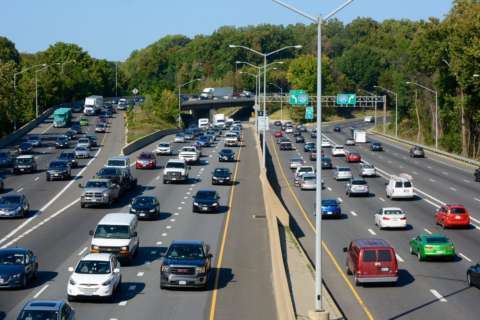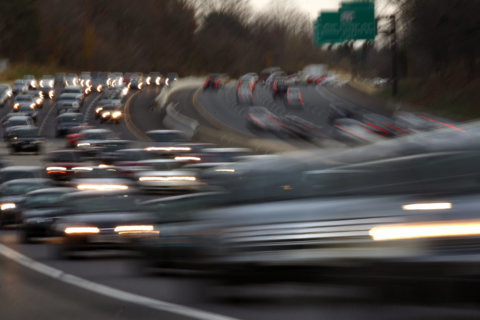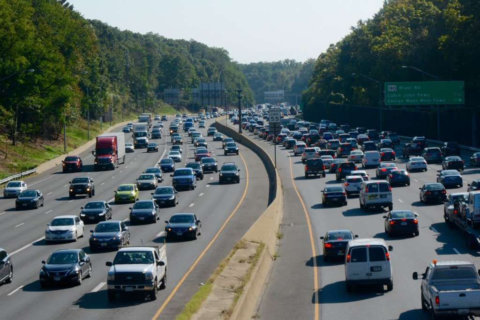Toll lane plans for parts of the Capital Beltway and Interstate 270 are set to move forward next week, including plans for improvements to the American Legion Bridge.
Maryland’s Board of Public Works — Gov. Larry Hogan, Treasurer Nancy Kopp and Comptroller Peter Franchot — is set to formally designate the planned toll lanes as a public-private partnership on May 8 and to support plans for separate phases of construction.
Once the public-private partnership designation is approved, the state expects to quickly issue a request for qualifications from private companies so that a short list of the private firms or groups that would design, build, finance, operate and maintain the Beltway toll lanes from the American Legion Bridge to Interstate 95 could be finalized in July.
There is still some sharp opposition to the plan from groups who would prefer transit options also be included.
Private groups would lead final design and construction to rebuild the regular roadway lanes and to add the toll lanes. The state will still be responsible for maintenance of the regular lanes after the project is done and would provide certain tolling operations support. The private company or companies would operate and maintain the toll lanes under a 50-year contract that entitles them to all toll revenues after any required debt payments.
The preferred design alternative is expected to be selected this winter from options for single or double toll lanes each way that may or may not allow HOV users and buses to ride free. Vehicles in the variably priced toll lanes would be guaranteed speeds of at least 45 mph, so the state appears warmer to two-lane options that would provide room for drivers to pass each other.
The shortlisted groups would get details of the planned bidding requirements in August to allow for private discussions with state officials about any changes that may be requested before a final request for proposals is issued in March 2020.
Bids would be due four to five months later, with a winning bidder selected in Sep. 2020.
Actual construction on Legion Bridge improvements and the toll lanes over the Potomac to Interstate 95 would take a number of years, but could begin in 2021 or 2022.
The state’s goal is to begin work on a second phase of toll lanes up Interstate 270 to I-370 (Shady Grove) and an extension of the Beltway toll lanes past Md. Route 5 within two years after that under separate deals with potentially different private companies.
“When all phases are complete, the Program will constitute an integrated system providing regionwide congestion relief,” the board’s briefing documents said.
The toll lanes could be extended further up Interstate 270 or across the Wilson Bridge at some point farther down the line.
Voting details
State Highway Administration reviews conclude Maryland would not be able to pay for major widening of the Beltway and Interstate 270 without setting up tolls and promising decades of the revenue to private companies.
“Projects require user fees or tax dollars regardless if a P3 is used,” the project’s public presentations say.
In this case, Maryland’s tolling agency, the MDTA, could issue bonds to support the project and the private companies involved can also take out debt backed by future toll payments.
Virginia used similar agreements to let private companies build and operate the 95 Express Lanes and the under-construction Interstate 66 toll lanes between the Beltway and Gainesville.
Maryland’s initial request for qualifications to be released next month is expected to include details of the construction and operation requirements, the amount of debt the MDTA expects to support, and outlines of other aspects of the expected contract.
“The proposed P3 delivery will incentivize on-time and on-budget delivery because the developer will not receive toll revenues until it opens the lanes for use,” the Board of Public Works documents said.
The board documents indicate the panel is getting additional information about the project, but that supplemental presolicitation report with additional public feedback, federal permitting updates and phasing plans was not immediately available. The broad strokes track similar information presented at public meetings this month.
There are additional workshops May 14 at Oxon Hill High School and May 16 at Seneca Valley High School. Federal environmental reviews require additional public input after a recommended alternative is selected later this year or early next year.
The state has already identified homes, businesses and parks that may need to be taken as part of construction, but final designs are still several years away so it is not clear how much if any of those properties will actually need to be taken in the end.
A number of local leaders have expressed concerns.
Earlier this month, the state said building any of the proposed toll lanes would provide an opportunity for faster trips for drivers than if nothing gets built, with 20 to 35 percent less delay in 2040 thanks to the roadway widening.
The state also believes more cars would use the highways under the plan, which could mean some current traffic is drawn off local roads.







